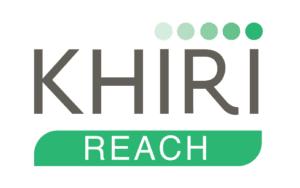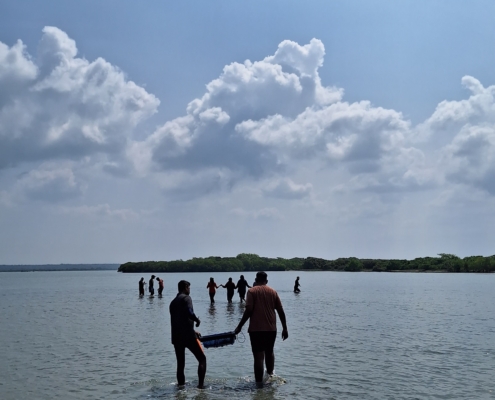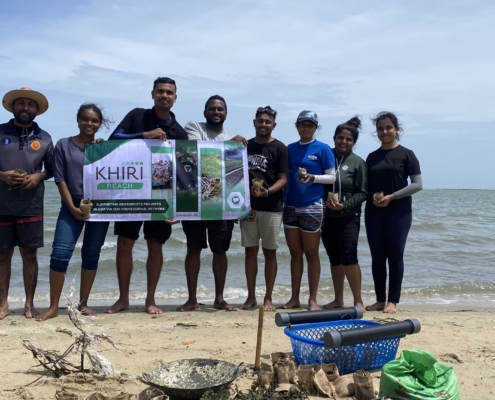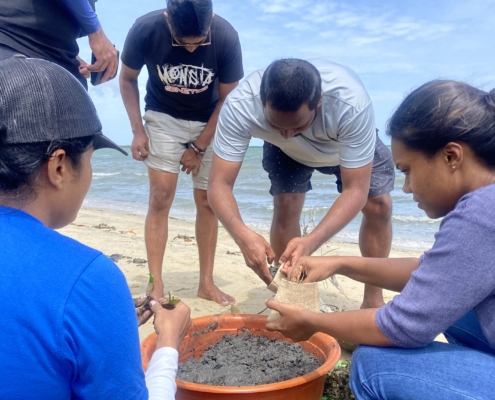Seagrass Restoration Project
This Seagrass Restoration project main goal is to transplant one hectare of seagrass within a year, ensuring the long-term survival of seagrasses. The project also involves conducting research on seagrass restoration. Over the coming years, OCEA aims to inspire future major projects in other areas to restore seagrass meadows, thereby supporting Sri Lanka’s climate, fisheries, and coastal livelihoods.
Sri Lanka has 14 seagrass species to choose from, but OCEA focused on ribbon seagrass (Cymodocea sp.) and turtlegrass (Thalassia hemprichii), as they are the most common species and thrive around Sri Lanka’s coasts. OCEA tested planting seagrass plugs using various techniques, and the latest technique appears to be a promising way to re-establish seagrass in shallow coastal areas. The lessons learned from these trials are now being applied in a larger scale trial, aiming to plant one hectare within a year.
Since December 2023, Khiri Reach has been committed to Sri Lanka’s first major Seagrass Restoration project by OCEA (Ocean Conservation & Education Alliance) in Kalpitiya. Khiri Reach committed to supporting 0.5 hectares of seagrass restoration for one year.
UPDATE
In November 2023, our Khiri Reach Ambassadors and the staff in the Sri Lanka office volunteered at the seagrass restoration project managed by OCEA and were joined by two knowledgeable researchers there.
In July 2024, our Khiri Reach Ambassadors and the staff from the Sri Lanka office visited the seagrass restoration project. They were informed that the pilot project conducted during 2023-2024 had a success rate of approximately 80%, which is considered healthy as anything above 50% is considered successful.
With funding from Khiri Reach, they selected a new restoration site for a half-hectare area on Sinna Arichchalai Island nearby. Pre-restoration studies were conducted to check feasibility, which included the collection of soil samples, historical distribution, and the quality of abiotic and biotic factors. Necessary equipment was purchased.
During the visit, the team actively took part in the plant preparation process, which mostly did not require scientific expertise.
The team from OCEA, including their founder Chathurika, was there to carry out the following specialized tasks:
- Collecting seagrass plugs from the donor site
- Measuring surface water quality around the area (dissolved oxygen, salinity, temperature, turbidity, pH, and a variety of other parameters)
- Collecting soil and mixing it with compost fertilizer to make the optimum mix
- Planting the prepared plugs in jute hessian bags on the optimum underwater surfaces
- Collecting soil samples from both the donor site and the restoration site to conduct pre- and post-planting analysis
View progress report here: Seagrass Restoration Report 1 – Sri Lanka (PDF)
In March 2025, the Khiri Reach Sri Lanka team received a promising project update from our partner, OCEA, on the ongoing seagrass restoration efforts.
A total of 2,140 seagrass plugs were planted throughout 2024, covering an area of 0.5 hectares. The restoration site has shown a strong 77% success rate, indicating healthy regrowth and ecosystem recovery.
We’re also proud to share that an abstract from this research was published in the proceedings of RESCON 2024, with the subject “PRELIMINARY STUDY ON EVALUATING THE CARBON STOCKS PRIOR TO SEAGRASS RESTORATION IN SINNA ARICHCHAL, KALPITIYA, SRI LANKA” contributing to the growing body of knowledge on coastal ecosystem restoration.
This contribution adds valuable insight to the growing body of knowledge on blue carbon and coastal ecosystem restoration.
View the final report here: Seagrass Restoration Report 2 – Sri Lanka (PDF)
Khiri Reach Sri Lanka remains committed to supporting and monitoring this important project through the end of 2025, helping restore marine biodiversity in the region.















